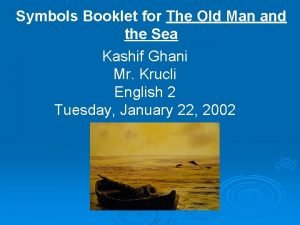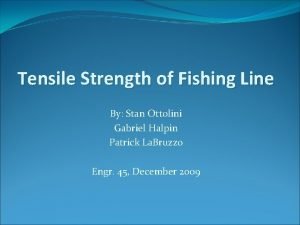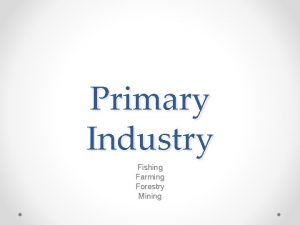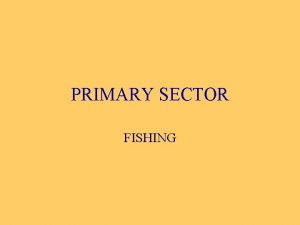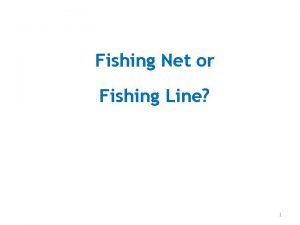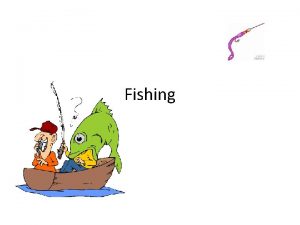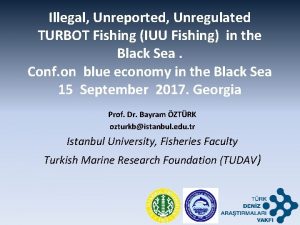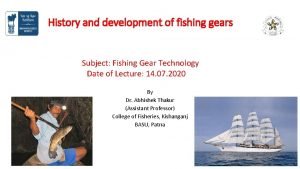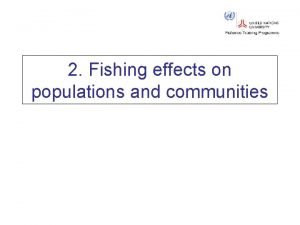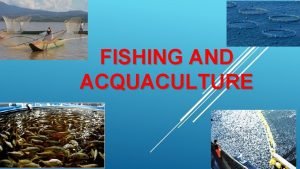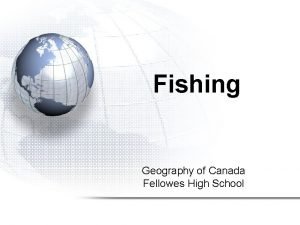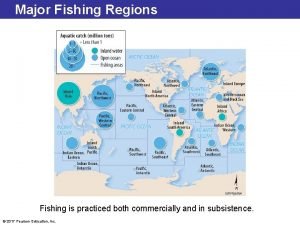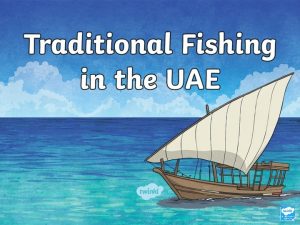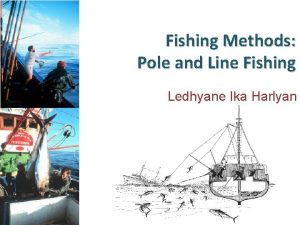FISHING Importance of sea resources The sea is

















- Slides: 17

FISHING

Importance of sea resources • The sea is the store-house of various important resources- food, raw-materials and other valuable products. • Minerals like salt, bromine and magnesium • Great supplier of food. Fish provide necessary protein in the diet, also mineral salts, iodine and vitamin D products. • Areas with great density of population and low per capita land for subsistence, fisheries become important part of economy. • Other marine products include iodine and potash from sea-weeds, leather from the hides of sea animals like whales, pearls, corals, oysters, clams, crabs, shrimps, sponges etc. • Hydrogenated whale oil is used in glycerine, soap, varnishes and glue. • Major source of employment.

• • • Out of annual fish catch. Asia- 40% Europe (including Russia)- over 30% North America-10% Consumption per capita is highest in Portugal and Japan In N. America, fresh water fishing for trout, perch, pike or salmon in rivers and lakes is part time occupation and hobby Inland fishing is important in the Caspian sea, lake Baikal and in East Asia. In China and Japan inland fishing in rivers, lakes and paddy fields is imp. Fish farming is common. Fishes found near the surface in open sea are called pelagic type like tuna, salmon, sardines, mackerels, herrings etc. Fishes found at depth are called demersal like haddock, flounders, cod and halibut.

Existaence of banks Long coastlines with indentations for carrying out fishing operations Depth and temperature of water Sunlight, ocean current, vertical mixing, chemical contents of the sea • Cool climate- also helpful for preservation • Tropical waters not shallow and contain no banks, purchasing power, single specie in large no. not found, commercially not developed like canning and refrigeration, not edible and temperatures are high which are not conducive to hard work, transport not developed. Instead pearl fishing is developed. • Factors more favourable in temperate waters • •

Fishing areas of the world • The North-west Pacific seas bordering central and northern Japan, northern China, Korea and North -eastern U. S. S. R. • The North-west Atlantic coast of Newfoundland New England • The North-east Atlantic shallow waters off the European coast extending from the Barents Sea in the north of the Bay of Biscay • The North-east Pacific from Alaska to California

• The major fishing grounds are located in the cool waters of the northern hemisphere in comparatively high latitudes. • Commercial fishing is little developed in the tropics or in the southern hemisphere. • The best fishing grounds are not more than 200 mts below the water surface, where planktons are most abundant.

• The world’s most extensive continental shelves are located in high or mid latitudes in the northern hemisphere. E. g. the banks of Newfoundland, the North sea and the continental shelf of north-western Europe, and the sea of Japan. • Plankton are in plentiful supply in polar waters, at the meeting of cold and warm currents or where the ocean floor wells up to the surface as it does off the west coast of South America. • Marine life is found to be best developed in oceans with temperature lower than 20°C. The continental shelves of the tropics are relatively less rich in plankton because the water is warm.


The Atlantic and Pacific coastlines (middle and high latitudes) • Highly indented coastlines • Backed by strong relief • Sheltered inlets and estuarine coasts that make ideal sites for fishing ports and villages. • Account for 80% of the total fish catch. • (15% is fresh water fishing) • Japan leads. Other imp countries are Russia, China, Norway, U. S. A

North-west Pacific Extends from the Bering Sea to the East China Sea Japan occupies a strategic position for fishing. The mixing of two currents, Kuroshio warm waters with the cold waters of the Oyashio favours the vigorous growth of fish in the inter-island straits and in the nearby shallow waters. Total production % marine products of the world Japan has a total coastline of 17000 miles. The areas of Japan’s coastal fishing grounds is 9 lakhs sq. miles. Vast and extensive types of fishes like cod, herring, salmon, mackerel, trout, bonito, tuna and lobster. Besides Japan, the pacific waters east of Japan and the Yellow and China seas and the coasts of Korea and Karafuto and the margins of the Okhtosk sea (Soviet Union, Korea and China coasts)

North-west Atlantic (the coasts of Newfoundland & New England)- cod fishing region • They extend from Nantucket to the eastern coast of Newfoundland, a distance of 1100 miles with an width of 50 to 250 miles. • The continental shelf is very broad and has many banks. Grand Banks, Sable Island Bank, Geroges Banks (Cod, Haddock, herring, mackerel, flounder) • Good breeding ground for fish as it is the meeting point of the warm Gulf stream and cold Labrador current ( 45°N to 55°N) and a melting place of icebergs released from Greenland. So it abounds in Organic food and plankton. • The cold current bring minerals from the land on which plankton thrive.

• The cool temperate climate not only favours large scale fishing but also preservation and storage of fish. • Modern canning and refrigeration facilities have greatly helped the fish export trade to progress. • Menhaden caught in the waters bordering Virginia, North Carolina and mid-atlantic states is an important source of oil required in the manufacture of soap, paints etc. • St. John, Halifax, Portland, Glouchester, Nova Scotia, Providence, Boston and New york are the ports where fishing is largely done. • Fishing vessels of France, Great Britain, Portugal and Italy undertake fishing in this area.

North-east Atlantic (Coasts of North- west Europe) • Extends from Iceland to the Mediterranean shores. • Pelagic, demersal and inshore fishing are all done on a highly organized basis by the European countries such as Norway, Denmark, Spain, Iceland the U. K. • Fishing done all year round in the shallow waters of the North Sea, the most exploited area being the Dogger bank. • The busiest fishing season is spring and the principal fish caught are herring, cod and mackerel. • The region is the greatest fish exporting region of the world.

North East Pacific Region • Adjoining the western shores of North America from Alaska to California • Salmon is the most valuable fish her • Highly irregular and indented coastline • In the warmer waters of California coast, tuna and sardines are important. • Crabs, shrimps and oysters are also caught.

Other regions • Off the coasts of Peru and Chile- cold Peru currents meet warm north Equatorial current to create good conditions for plankton development, even though the continental shelf is narrow. Anchovies are found in good no. Fishes caught are used to make fertilizers • Argentina coast • Southern coast of South Africa. • South-east Australian coast • South-east Asian region-Sulu sea, Java sea and Celebes sea- fishing on small scale but considerable potential for expansion available.

• Whaling-Arctic and Antarctic waters • Leading whaling nations are Japan and Russia • Endangered and scarce so environmentalists are against this. • Pearl Fishery derived from oyesters • High quality pearls are from Persian Gulf, shores of Sri Lanka, Japan, Western Australia, Queensland Northern Australia. • Also produced in Mexico, the gulf of California and wherever there are coral reefs

Problems • Overfishing with the help of modern techniques and closely knit nets. • Many varieties becoming endangered like salmon and Halibut • Heavy ocean traffic like between eastern USA and west Europe leads to pollution and discharge of effluents into the sea • Pollution from various sources- city effluents, nuclear and industrial waste, leakage from trans oceanic pipelines, mining in ocean beds- all threaten fish resources.
 Renewable vs nonrenewable resources worksheet
Renewable vs nonrenewable resources worksheet Operation transformation process
Operation transformation process Example of fixed resources
Example of fixed resources Importants of hrm
Importants of hrm Imp of water resources
Imp of water resources Aegean sea troy
Aegean sea troy Sea stack diagram
Sea stack diagram Yellow sea and east china sea
Yellow sea and east china sea Hydra anemone
Hydra anemone What does the sea symbolize in the old man and the sea
What does the sea symbolize in the old man and the sea Jim conlon
Jim conlon Tensile strength of fishing line
Tensile strength of fishing line Butt widening joint
Butt widening joint Class of lever examples
Class of lever examples Fishing and mining
Fishing and mining Auto motion works
Auto motion works Wallfish cable definition
Wallfish cable definition Adjective clauses
Adjective clauses









